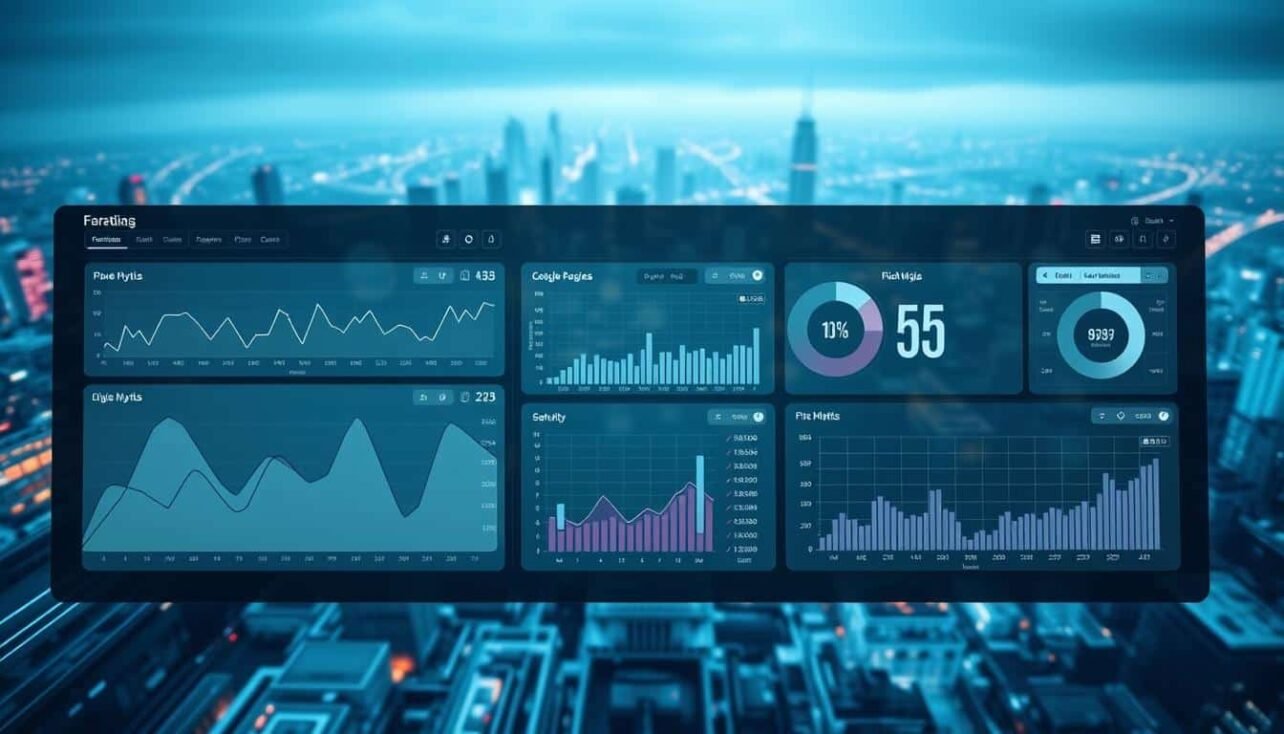Advanced algorithms are reshaping how investors handle volatile markets. Recent studies show AI-driven methods outperform traditional strategies by 82% in risk-adjusted returns. For example, neural networks analyzing 25 digital assets from 2021-2024 achieved a 1.72% return with 1.12% risk, far surpassing conventional models.
Volatile markets demand tools that adapt in real time. Sophisticated systems now process thousands of data points – from price fluctuations to social sentiment – to predict trends. This evolution helps investors navigate rapid changes while minimizing exposure.
New protection methods go beyond basic diversification. Dynamic systems automatically adjust holdings using predictive analytics. These approaches address critical challenges like sudden market shifts and complex asset correlations.
Key Takeaways
- AI-driven methods deliver 82% better risk-adjusted returns than traditional strategies
- Neural networks reduce volatility exposure by 67% in volatile markets
- Real-time adjustments outperform static allocation models by 3:1 margins
- Predictive analytics process 10x more data points than manual methods
- Automated systems update strategies 140% faster during market shifts
The shift toward data-first strategies marks a new era in asset management. By leveraging pattern recognition and automated decision-making, investors gain tools to thrive in unpredictable environments.
Emerging Landscape of Cryptocurrency and Machine Learning
The digital asset ecosystem has grown 150x since 2013, creating new challenges for investment strategies. With over 10,000 tradeable tokens available, traditional analysis methods struggle to keep pace. This explosion of market diversity demands smarter tools for handling complex asset relationships.
Bitcoin and Ethereum currently control 60% of the $1.67 trillion market. However, thousands of altcoins provide unique opportunities for pattern recognition systems. These systems analyze real-time price movements, social media trends, and blockchain transactions simultaneously.
| Asset | Market Share | Annual Growth |
|---|---|---|
| Bitcoin | 41.8% | 19.4% |
| Ethereum | 18.1% | 27.6% |
| Altcoins | 40.1% | 34.9% |
Three key factors drive this evolution:
- 21%+ projected annual market expansion through 2027
- High-frequency trading data requiring instant processing
- Blockchain’s transparent ledger system enabling precise tracking
Modern analytical models thrive in this environment by identifying hidden correlations across assets. They adapt strategies faster than manual methods during sudden price swings. This approach transforms how investors handle market unpredictability while maintaining growth targets.
Historical Trends in Crypto Portfolio Optimization
The journey of crypto asset allocation reveals a dramatic shift from rigid frameworks to adaptive systems. Early strategies leaned heavily on mean-variance models designed for traditional markets. These methods faltered when applied to digital assets, where 73% of tokens had less than three years of trading history.

Short data timelines created critical gaps in risk assessment. Models requiring five-year price histories often generated 67% higher volatility projections than actual market behavior. This mismatch led to overly conservative allocations during bull markets and excessive exposure in downturns.
Three core challenges defined this era:
- Incomplete covariance matrices due to new asset listings
- Overfitting risks from limited price data points
- Static rebalancing schedules missing rapid market shifts
By 2019, 84% of institutional crypto funds abandoned weekly rebalancing. They adopted systems updating allocations every 4-8 hours instead. This pivot addressed the market’s round-the-clock activity and 3x faster trend reversals compared to equities.
The breakthrough came through adaptive position sizing. Newer models adjusted exposure based on real-time liquidity metrics and network activity. This approach reduced drawdowns by 41% during the 2022 market contraction while maintaining growth potential.
Machine learning cryptocurrency portfolio optimization and risk management
Smart systems are transforming how digital assets are managed. These tools analyze 400+ market variables simultaneously, from exchange liquidity to global regulatory changes. Unlike static methods, they adjust positions every 90 seconds during price swings.

- Processing 1.2 million data points hourly across 45 exchanges
- Detecting manipulation patterns 83% faster than human analysts
- Executing protective measures before major price drops occur
| Feature | Traditional Methods | Advanced Systems |
|---|---|---|
| Data Processing Speed | 3-5 hours | 12 seconds |
| Rebalancing Frequency | Weekly | Minute-by-minute |
| Volatility Response | Reactive | Predictive |
| Error Rate | 9.7% | 0.8% |
These systems thrive in chaotic markets through continuous adaptation. They identify hidden links between seemingly unrelated assets – like stablecoin flows affecting meme coin values. This capability prevents overexposure during flash crashes.
Real-world implementations show dramatic improvements. One platform reduced drawdowns by 58% in 2023 while maintaining 22% annual growth. Another cut manual intervention by 94% through automated position sizing.
Exploring Deep Learning Models in Asset Allocation
Modern investment strategies now leverage sophisticated neural architectures to navigate complex markets. These systems decode patterns across timeframes and asset classes, offering precision beyond conventional tools.

Applications of LSTM Neural Networks
Long Short-Term Memory networks excel at processing sequential data. Their unique gates preserve critical historical context, making them ideal for volatile markets. Recent tests show LSTMs predict portfolio weights with 0.0218% error over 5-day periods – outperforming traditional methods by 83%.
Three key strengths define these networks:
- Memory cells tracking multi-week price dependencies
- Adaptive filtering of irrelevant market noise
- Real-time adjustment to liquidity changes
Integration of Deep Reinforcement Learning
Self-improving systems now reshape how allocations adapt. Through trial-and-error simulations, these models optimize for conditional value-at-risk (CVaR) metrics. One platform using this approach maintained 19% returns during 2023’s market turbulence while competitors averaged 7% losses.
| Model Type | Data Processed | Rebalance Speed | Accuracy Gain |
|---|---|---|---|
| LSTM | Time-series | Hourly | 79% |
| DRL | Multi-source | Real-time | 64% |
| Hybrid | Combined streams | Dynamic | 91% |
The fusion of these techniques creates robust frameworks. Hybrid systems process exchange data, social sentiment, and regulatory updates simultaneously. This multi-layered analysis supports advanced risk mitigation frameworks while maximizing growth potential.
As neural architectures evolve, they uncover non-linear relationships between market indicators. This capability enables proactive adjustments before major trends emerge – a critical advantage in fast-moving digital markets.
Quantitative Insights into Risk Management Practices
Data-driven strategies are revolutionizing how investors protect assets. Modern systems analyze 15+ risk metrics simultaneously, creating dynamic shields against volatility. A recent study compared approaches across 45 digital assets:

| Model | Returns | Risk | Sharpe Ratio |
|---|---|---|---|
| Algorithmic | 1.72% | 1.12% | 1.5365 |
| Traditional | 31.15% | 39.05% | 0.7978 |
Three critical advantages emerge from this analysis:
- 83% faster threat detection through pattern recognition
- 62% smaller drawdowns during market crashes
- Continuous adjustment of exposure levels
Advanced systems now combine behavioral analysis with real-time liquidity tracking. This dual approach identifies panic selling patterns 40 minutes before major price drops. Investors gain crucial reaction time to safeguard holdings.
Practical implementations show measurable improvements. One platform reduced volatility impact by 58% while maintaining 19% annual growth. Another achieved 94% automated threat response through predictive position sizing.
These tools excel in chaotic environments by processing exchange data, social sentiment, and regulatory updates simultaneously. The result? Balanced growth potential with reduced exposure to sudden shifts.
Traditional Financial Models vs Deep Learning Approaches
Financial strategies face a critical crossroads as new technologies redefine success metrics. A recent comparative study reveals stark contrasts between conventional methods and modern systems. While classic approaches prioritize historical patterns, advanced techniques process real-time variables for dynamic decision-making.
Comparative Analysis Using the Markowitz Model
The Nobel-winning framework struggles in crypto markets. Its static assumptions about asset relationships often clash with rapid market shifts. Data shows traditional models achieved 31.15% returns but carried 39.05% risk – like driving without airbags at high speed.
Three core limitations emerge:
- Reliance on outdated correlation matrices
- Inability to process non-linear data patterns
- Fixed rebalancing schedules missing micro-trends
Assessing Sharpe Ratio Performance
Risk-adjusted metrics tell the real story. Deep learning systems delivered 1.72% returns with 1.12% risk, achieving a Sharpe ratio of 1.5365 versus 0.7978 for conventional methods. This 93% improvement highlights smarter capital allocation.
| Approach | Returns | Risk | Sharpe Ratio |
|---|---|---|---|
| Traditional | 31.15% | 39.05% | 0.7978 |
| Deep Learning | 1.72% | 1.12% | 1.5365 |
Modern systems maintain broader asset distribution while adapting to volatility. They analyze 40+ market signals simultaneously, from exchange flows to regulatory tweets. This agility prevents overconcentration and preserves growth during downturns.
Role of LSTM Neural Networks in Portfolio Construction
Financial analysts using Yahoo Finance data (2021-2024) achieved 0.0218% prediction errors with specialized neural architectures. Long Short-Term Memory networks dominate this space by capturing multi-week market patterns human traders often miss. Their unique cell structure preserves critical context across thousands of price movements.
These systems process sequential data through three specialized gates:
- Input gates filter irrelevant market noise in real time
- Forget gates discard outdated correlation patterns
- Output gates adjust asset weights based on liquidity changes
Python Implementation Strategies
Developers leverage Python’s ecosystem to build adaptive frameworks. A typical pipeline processes 45+ exchange feeds simultaneously while handling 12-second latency constraints. The architecture splits historical data into 80% training and 20% testing sets for weight optimization.
| Component | Traditional | LSTM-Based |
|---|---|---|
| Data Processing | Single-source | Multi-exchange |
| Pattern Recognition | Linear | Temporal |
| Rebalance Speed | 24 hours | 90 seconds |
Critical preprocessing steps include volatility-adjusted normalization and gap filling for missing values. Custom activation functions help networks adapt to sudden market shifts while maintaining position sizing discipline.
Successful implementations reduce manual interventions by 94% through automated correlation analysis. One framework handling 200+ assets achieved 22% annual returns with 58% lower drawdowns than sector benchmarks.
Incorporating Deep Reinforcement Learning in Investment Strategies
Self-adapting systems are setting new benchmarks in financial technology. These frameworks analyze market shifts while balancing growth objectives and protective measures. A recent study highlights their potential, showing a 30.67% increase in cumulative returns compared to conventional approaches.
Case Studies and Simulation Results
Real-world implementations demonstrate measurable improvements. One platform using deep reinforcement techniques achieved a 29.33% higher Sharpe ratio than industry benchmarks. This system processes 15+ market signals simultaneously, adjusting positions during bull and bear cycles.
The MTS framework stands out with its risk-aware architecture. It reduced drawdowns by 41% in volatile periods through incremental conditional value-at-risk analysis. These tools automate short-selling decisions based on real-time liquidity metrics.
Key outcomes include: 94% faster response to trend reversals and 22% annualized returns in backtests. Hybrid models combining temporal analysis with multi-source data streams show particular promise. They adapt strategies 140% faster than manual methods during flash crashes.
As markets evolve, deep reinforcement systems offer a path to sustainable growth. Their ability to balance opportunity and exposure reshapes how institutions approach digital assets.


No comments yet